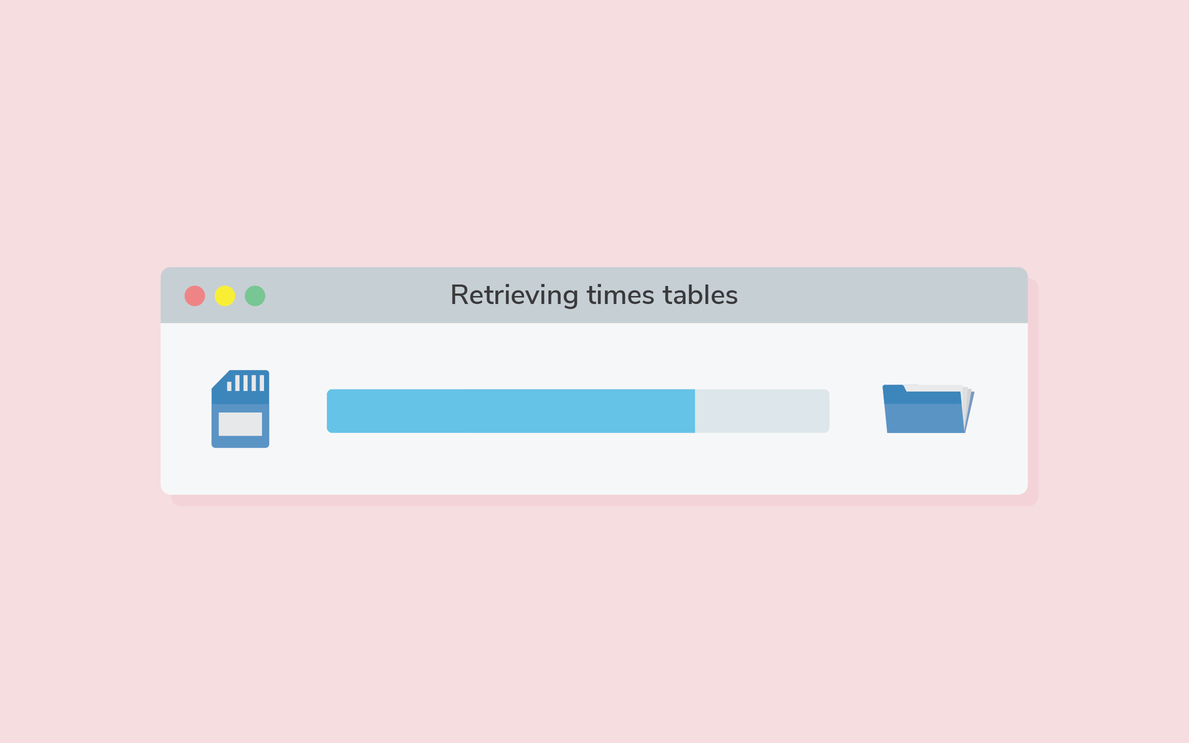More tips for teaching multiplication facts recall
Regular practice is crucial. Two minutes once a day will make far more impact than ten minutes once a week.
In my last blog, I shared four tips for teaching multiplication fact recall to boost maths fluency. Now that you’ve got the basics, what else can you do to teach pupils to effortlessly recall multiplication facts?
Define what ‘fluent’ means
It’s important to be clear about what you mean when you say you want pupils to have a fluent recall of multiplication facts. What does it mean to be fluent?
A.J. Baroody outlines three phases of factual fluency in mathematics:
Phase 1: Counting strategies
- Children use fingers, cubes or some other concrete resource to determine the answer. In other words, they can do it if they can use something to help them.
Phase 2: Reasoning strategies
- Children use known facts and relationships to work out the answer. They can do it if they think about it.
Phase 3: Mastery
- Children arrive at the answer quickly and accurately. They just know it.
Pupils won’t reach Phase 3 without first passing through Phases 1 and 2. Different pupils will spend varying amounts of time getting to Phase 3, but it’s our job to recognise where they are and support them to reach the next stage.
Here is an example of how you can guide your pupils through the stages:
If you’re working on the 3 times table, Phase 1 could begin with counting one group of three objects, then another group, then another, so pupils can see the pattern. Initially, pupils will most likely try to count every object. To help them along, try saying softly “one, two” then more loudly “three,” then softly “four, five” then more loudly “six,” and so forth.
Then you could try steering them to a strategy such as touch-count. Count in threes but use fingers to keep track. For instance, touch the first finger as you say “three,” the second finger as you say “six,” etc. At the same time, practice using the full auditory soundbite to question pupils so that they connect touching their second finger with “two threes are six.”
Once pupils can do this easily, move to Phase 2 Reasoning Strategies. For example, I know that 10 x 3 = 30; therefore, to find 11 x 3, I can just add another 3.
How can we support our pupils to reach that secure, Phase 3 level of fluency?
Transform Your Maths Assessment
Insights — our online assessment tool — gives you instant, powerful data to identify gaps and improve results.

Exploring structures, making connections
It’s a good idea to teach pupils how to spot patterns and make generalisations while they practise with the counting stick. Some examples of questions you can ask are:
- If one of the factors doubles, what happens to the product?
- If I halve the product, what happens to the factors?
- What do you notice about the pattern of odd and even products?
Not only is this another way for pupils to make connections for storing knowledge in their long-term memory, but it also provides pupils with strategies to use if they can’t immediately recall a fact.
Regular practice
Regular practice is crucial. Two minutes a day will make far more impact than ten minutes once a week. Two minutes twice a day is even better!
I like to practise using the Skip Counting PowerPoint slides which can be downloaded for free from FunKey Maths’ Library. You don’t have to use these, but I find them far easier than manipulating a physical counting stick.
By the way, if you’re unfamiliar with using a counting stick, this video shows you how expert Jill Mansergh does it.
Make effective use of testing
Teach, don’t test! It’s important to test pupils so you know what they still need to learn, but if you don’t make use of the information the test gives you, what’s the point in doing it?
Are many pupils in your class struggling with the same multiplication fact? In that case, make it a focus, rehearsing it as often as possible throughout the day. Or do you have a small group of children who are struggling with the same multiplication facts? Then think about ways you can support them to make the connections. Connect different representations — Concrete-Pictorial-Abstract and language — with the way you say the fact. If you consistently use the auditory sound bite with the same image, over time pupils will be able to draw on those connections and be able to recall the facts when asked.
Don’t panic!
Most importantly, don’t panic, and don’t let your pupils panic either.
Yes, we know how much some Year-5 pupils struggle with fractions if they don’t know their tables — they can’t yet spot the patterns that create mathematical connections. And as they move into Key Stage 3 and Key Stage 4, this becomes an ever-greater issue. Therefore, it’s important we do everything we can to build fluent recall of multiplication facts.
However, for about one third of pupils, the onset of timed testing is the beginning of math anxiety, says Jo Boaler in her article Fluency without Fear.
There is now an extensive body of research on maths anxiety which outlines the way it prevents the brain from working efficiently. In our efforts to ensure they can fluently recall the facts needed to progress in their mathematical learning, we must be acutely aware of the dangers of setting pupils on that path to maths anxiety.
I hope the strategies outlined in these blog posts give you the tools you need to ensure your pupils experience the boost in confidence and enjoyment that comes with succeeding in attaining true fluency in their recall of multiplication facts.
